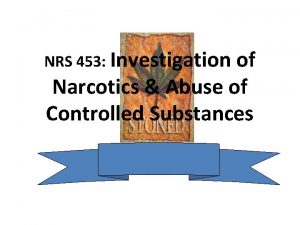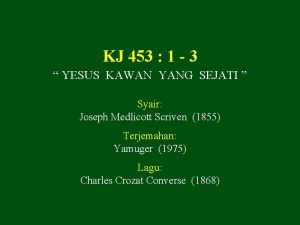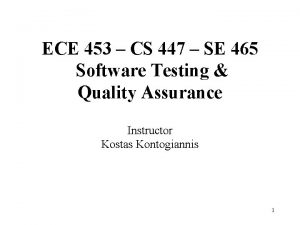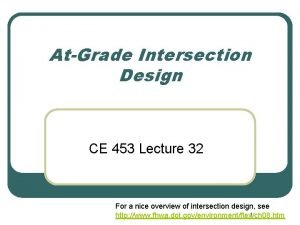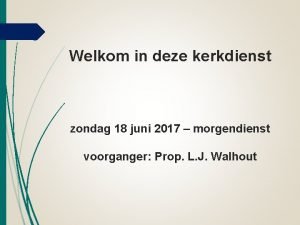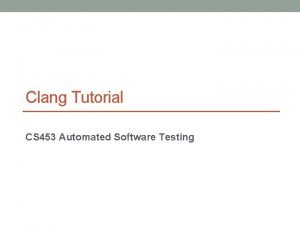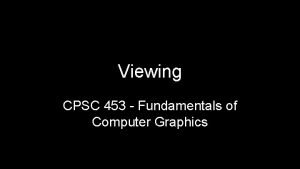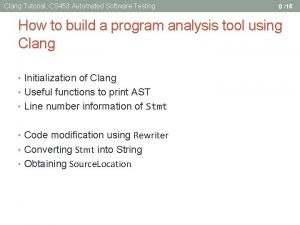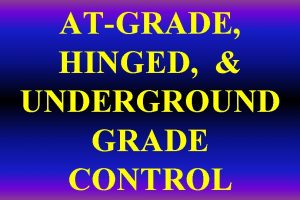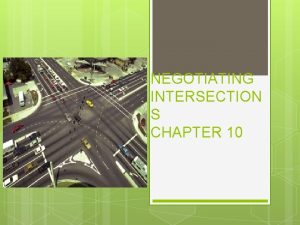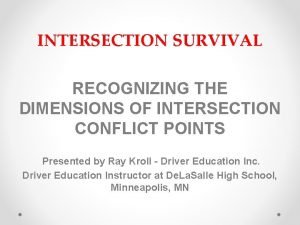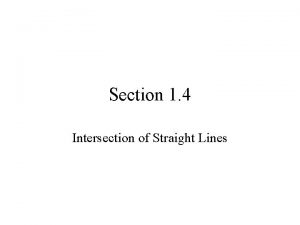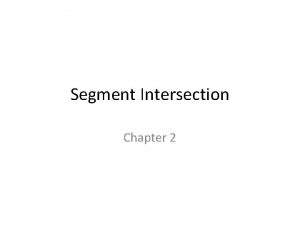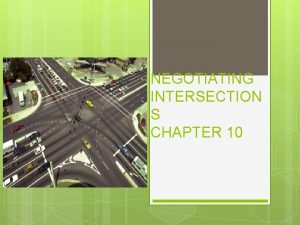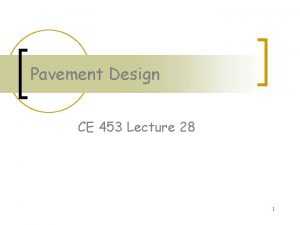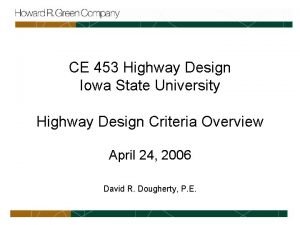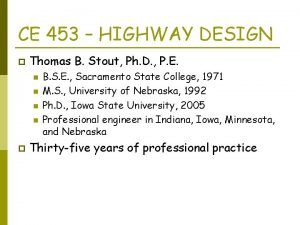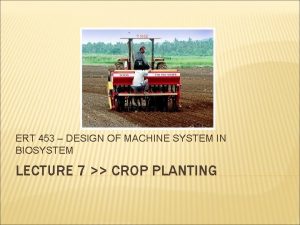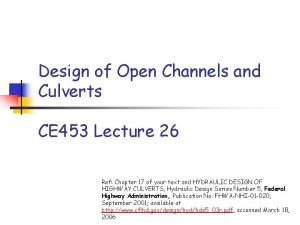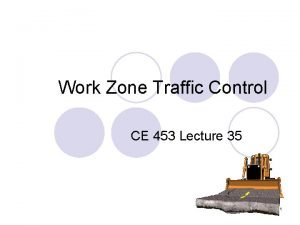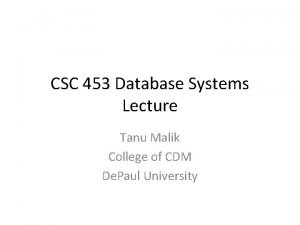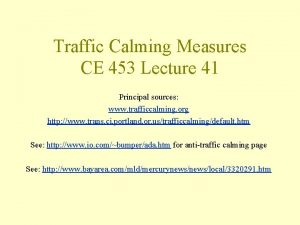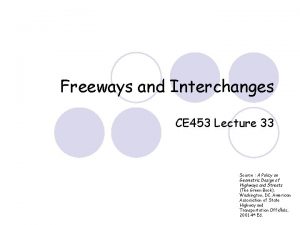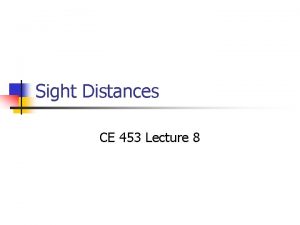AtGrade Intersection Design CE 453 Lecture 32 For






































- Slides: 38

At-Grade Intersection Design CE 453 Lecture 32 For a nice overview of intersection design, see 1 http: //www. fhwa. dot. gov/environment/flex/ch 08. htm

2

3

4

Design Vehicle Source: wwwfhwaFlexibil ity in Highway Design - Chapter 8 - FHWA. htm 5

Curb Radius l Factors of influence: • Design vehicle • Intersection angle • Approach width and parking • Channelization • Pedestrians • Allowable speed reduction 6

Curb Radius l Green Book Minimums assume: • Turning Speed LTE 10 mph • Vehicle properly positioned beginning and end • Vehicle doesn’t cross inner edge of pavement 7

Radius Design • Simple curve • Low speed collector, local streets • Simple circle with taper • 3 -centered compound curve 8

Curb Radius l General Guidance • • • 10 to 25 ft. local 25 to 30 ft. collectors 30 to 35 ft. unchannelized intersections with arterials 9 Source: wwwfhwaFlexibility in Highway Design - Chapter 8 - FHWA. htm

Minimize lane encroachment R = 15 feet 10

Simple Curve (passenger car template) 11

Simple Curve with Taper (passenger car template) 12

Compound curves (passenger car template) 13

14

15

16

High Speed Turns 17

Intersection Design Considerations for Pedestrians 18

19

Provide median refuge to provide crossing in stages 20

Provision of crosswalks 21

Intersections on High Speed Rural Divided Expressways - Tom Welch, State Traffic Safety Engineer 22

23

24

25

26

High speed expressway intersections l l We are building many rural expressways At-grade intersections can be very dangerous Don’t use traffic signals as a safety measure (in most cases) - leave as 2 way stop or replace with interchange There alternate measures … 27

Alternate measures l install double yellow center line and stop bars in the median • l l maintain and replace frequently When resurfacing, look for opportunities to install more and longer left and right turn lanes Paving shoulders near the intersections Build "T“ intersections or even offset "T" intersections • much fewer conflict points Use a restricted median • • allow lefts in and rights in and out prohibit lefts out and cross traffic 28

Alternate measures l l ask local newspaper to publish an article which explains the proper way to cross and enter a divided roadway. • • • stop, look left only and enter into the median stop in the median look right and then cross or turn left onto the expressway • • • Signs need to be on both sides to work (where fast aggressive drivers operate) In low volumes, traffic may not slow down In peak hours (most Important because most turns), almost always one person in the platoon slows down - whole platoon slows Wisconsin pioneered advisory speed limit 10 mph below the posted speed 29

30

31

US 65 Bondurant Example l Speed study done before and after • Some problems with the speed plates • Intense enforcement during the before and • after period Data shows promise 32

33

Another idea … l l l median sign west on Boone on US-30 Initially solar powered strobe light above the sign to draw attention was distracting to drivers on US- 30 34

Change Blindness l l l l a psychological phenomenon In the past, motorists would pull up to a stop sign at a rural two lane highway and when they looked down the highway there would all kinds of buildings, fence posts tree etc along the narrow R/W and roadway They could easily note the change in position of approaching vehicles and better judge the approaching vehicular closing speed. Nowadays on our expressways, we cleanout the wide R/W, there are fewer buildings and trees along the R/W etc. So, now there is nothing left to help the driver judge the change in position of the approaching vehicles on the expressway. Imagine now a 75 year old driver with restricted eye sight, trying to judge the speed of a light colored vehicle up against the gray/ white horizon. Tough to judge approaching speeds 35

Overhead intersection beacons? l Recent research in Minnesota • • • ineffective confuse motorists (drivers may think the flashing red beacon means 4 way stop) now removing over head flashing intersection beacons in favor of red beacon on the stop sign 36

Traffic circles l l l Rotaries: large diameter > 300 ft, allows speeds > 30 mph with minimum horizontal deflection of the path of through traffic Neighborhood traffic circle: small diameter, for local streets, traffic calming Roundabout • Yield control at each approach • Separation of conflicting movements • Speed < 30 mph (typically) 37

38
 01:640:244 lecture notes - lecture 15: plat, idah, farad
01:640:244 lecture notes - lecture 15: plat, idah, farad Channelization in traffic engineering
Channelization in traffic engineering 250'nin 10 fazlasının 20 eksiği kaçtır
250'nin 10 fazlasının 20 eksiği kaçtır Nrs 453
Nrs 453 Kj453
Kj453 Cs 447
Cs 447 450 yüzlüğe yuvarlama
450 yüzlüğe yuvarlama Ce 453
Ce 453 Weerklank 453
Weerklank 453 Immune effector cells
Immune effector cells En 453
En 453 Cs 453
Cs 453 Nrs 453
Nrs 453 Compsci 453
Compsci 453 Normalized device coordinates
Normalized device coordinates Clang ast tutorial
Clang ast tutorial Ce 453
Ce 453 Fspos vägledning för kontinuitetshantering
Fspos vägledning för kontinuitetshantering Novell typiska drag
Novell typiska drag Nationell inriktning för artificiell intelligens
Nationell inriktning för artificiell intelligens Returpilarna
Returpilarna Varför kallas perioden 1918-1939 för mellankrigstiden?
Varför kallas perioden 1918-1939 för mellankrigstiden? En lathund för arbete med kontinuitetshantering
En lathund för arbete med kontinuitetshantering Adressändring ideell förening
Adressändring ideell förening Tidbok
Tidbok A gastrica
A gastrica Vad är densitet
Vad är densitet Datorkunskap för nybörjare
Datorkunskap för nybörjare Stig kerman
Stig kerman Debattartikel mall
Debattartikel mall Magnetsjukhus
Magnetsjukhus Nyckelkompetenser för livslångt lärande
Nyckelkompetenser för livslångt lärande Påbyggnader för flakfordon
Påbyggnader för flakfordon Formel för lufttryck
Formel för lufttryck Publik sektor
Publik sektor Kyssande vind analys
Kyssande vind analys Presentera för publik crossboss
Presentera för publik crossboss Teckenspråk minoritetsspråk argument
Teckenspråk minoritetsspråk argument Kanaans land
Kanaans land



